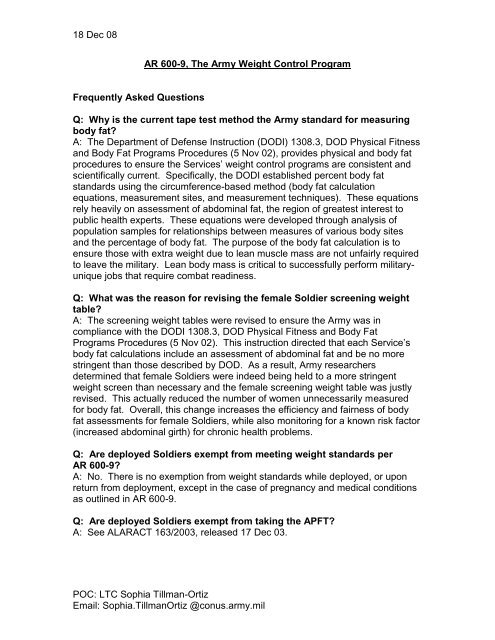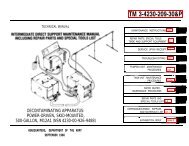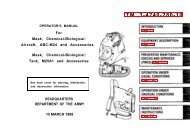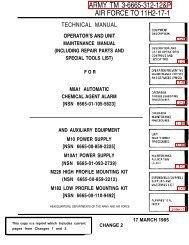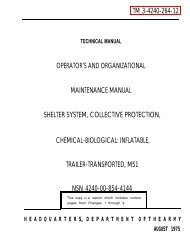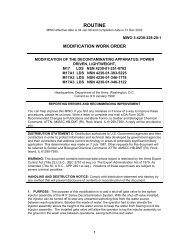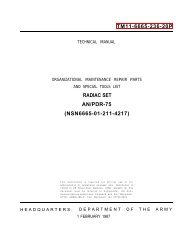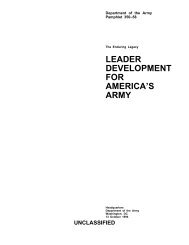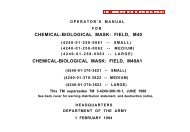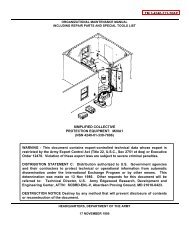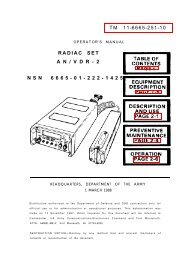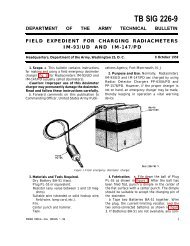AR 600-9, The Army Weight Control Program
AR 600-9, The Army Weight Control Program
AR 600-9, The Army Weight Control Program
Create successful ePaper yourself
Turn your PDF publications into a flip-book with our unique Google optimized e-Paper software.
18 Dec 08<br />
<strong>AR</strong> <strong>600</strong>-9, <strong>The</strong> <strong>Army</strong> <strong>Weight</strong> <strong>Control</strong> <strong>Program</strong><br />
Frequently Asked Questions<br />
Q: Why is the current tape test method the <strong>Army</strong> standard for measuring<br />
body fat?<br />
A: <strong>The</strong> Department of Defense Instruction (DODI) 1308.3, DOD Physical Fitness<br />
and Body Fat <strong>Program</strong>s Procedures (5 Nov 02), provides physical and body fat<br />
procedures to ensure the Services’ weight control programs are consistent and<br />
scientifically current. Specifically, the DODI established percent body fat<br />
standards using the circumference-based method (body fat calculation<br />
equations, measurement sites, and measurement techniques). <strong>The</strong>se equations<br />
rely heavily on assessment of abdominal fat, the region of greatest interest to<br />
public health experts. <strong>The</strong>se equations were developed through analysis of<br />
population samples for relationships between measures of various body sites<br />
and the percentage of body fat. <strong>The</strong> purpose of the body fat calculation is to<br />
ensure those with extra weight due to lean muscle mass are not unfairly required<br />
to leave the military. Lean body mass is critical to successfully perform militaryunique<br />
jobs that require combat readiness.<br />
Q: What was the reason for revising the female Soldier screening weight<br />
table?<br />
A: <strong>The</strong> screening weight tables were revised to ensure the <strong>Army</strong> was in<br />
compliance with the DODI 1308.3, DOD Physical Fitness and Body Fat<br />
<strong>Program</strong>s Procedures (5 Nov 02). This instruction directed that each Service’s<br />
body fat calculations include an assessment of abdominal fat and be no more<br />
stringent than those described by DOD. As a result, <strong>Army</strong> researchers<br />
determined that female Soldiers were indeed being held to a more stringent<br />
weight screen than necessary and the female screening weight table was justly<br />
revised. This actually reduced the number of women unnecessarily measured<br />
for body fat. Overall, this change increases the efficiency and fairness of body<br />
fat assessments for female Soldiers, while also monitoring for a known risk factor<br />
(increased abdominal girth) for chronic health problems.<br />
Q: Are deployed Soldiers exempt from meeting weight standards per<br />
<strong>AR</strong> <strong>600</strong>-9?<br />
A: No. <strong>The</strong>re is no exemption from weight standards while deployed, or upon<br />
return from deployment, except in the case of pregnancy and medical conditions<br />
as outlined in <strong>AR</strong> <strong>600</strong>-9.<br />
Q: Are deployed Soldiers exempt from taking the APFT?<br />
A: See AL<strong>AR</strong>ACT 163/2003, released 17 Dec 03.<br />
POC: LTC Sophia Tillman-Ortiz<br />
Email: Sophia.TillmanOrtiz @conus.army.mil
18 Dec 08<br />
Q: How do you calculate a female/male Soldier’s body fat percentage if<br />
her/his measurements are not on the tables in <strong>AR</strong> <strong>600</strong>-9?<br />
A: <strong>The</strong> following formula is the DOD body fat equation from DODI 1308.3, DOD<br />
Physical Fitness and Body Fat <strong>Program</strong>s Procedures (5 Nov 02). Insert the<br />
Soldier’s circumferences and height.<br />
NOTE: You will need to use a scientific calculator, which you will find on your<br />
computer (pull up calculator from programs and then click on view and choose<br />
scientific).<br />
NOTE: All measurements must be in inches<br />
SAMPLE (WOMEN): Neck = 15 in; Waist = 42 in; Hip = 44 in; Height = 64 in)<br />
<strong>The</strong> equation for women is:<br />
% body fat = [163.205 x Log (waist + hip – neck)] – [97.684 x Log (height)] – 78.387<br />
A. Solve: [163.205 x (Log [71])]. Take the Log [71] = 1.85 (when using a<br />
calculator, be careful not to use LN (natural Log). Instead, enter 71 and<br />
press the LOG key.<br />
B. Solve [97.684 x (Log [64])]. Take the Log [64] = 1.81 (when using a<br />
calculator, be careful not to use the LN (natural log). Instead, enter 64<br />
and press the LOG key.<br />
C. Solve the equation:<br />
% body fat – [163.205 x 1.85 – [97.684 x 1.81 – 78.387]<br />
= [301.93] – [176.81 – 78.387]<br />
= 47% (actual number is 46.73%; round to the nearest whole %)<br />
SAMPLE (MEN): Neck = 16 in; Waist = 49 in; Height = 69 in<br />
<strong>The</strong> equation for men is:<br />
% body fat = [86.010 x Log (waist – neck)] – [70.041 x Log (height)] + 36.76<br />
A. Solve: [86.010 x Log10 (33)]. Take the Log10 (33) = 1.52 (when using a<br />
calculator, be careful not to use LN (natural Log). Instead, enter 33 and<br />
press the LOG key.<br />
B. Solve [70.041 x (Log10 (69)]. Take the Log10 (69) = 1.84 (when using a<br />
calculator, be careful not to use the LN (natural Log). Instead, enter 69<br />
and press the LOG key.<br />
C. Solve the equation:<br />
% body fat = [86.010 x 1.521] – [70.041 x 1.841 + 36.76]<br />
= [130.74] – [128.88] + 36.76<br />
= 39% (actual number is 38.62%; round to the nearest whole %).<br />
Q: Is the Gulick tape authorized to use to measure body fat?<br />
A: No. Acceptable tape measures are made of nonstretchable material. <strong>The</strong><br />
Gulick tape has a spring loaded end that may get stretched over time, thereby<br />
making measurements inaccurate. <strong>The</strong> preferred method to ensure that the tape<br />
is applied correctly is to view the site that is being measured. <strong>The</strong> tape should<br />
make contact with the skin, conform to the body surface being measured, and<br />
not compress the underlying soft tissue.<br />
POC: LTC Sophia Tillman-Ortiz<br />
Email: Sophia.TillmanOrtiz @conus.army.mil
18 Dec 08<br />
Q: Are “love handles” measured when you obtain abdominal<br />
circumference?<br />
A: No. <strong>AR</strong> <strong>600</strong>-9 describes the abdominal circumference site as being at the<br />
level of the “belly button”. Consistency in measurement is an important aspect of<br />
doing the tape test correctly. Deviation from the prescribed techniques may lead<br />
to incorrect body fat measurements and an incorrect assessment on whether a<br />
Soldier is making progress in losing body fat.<br />
Body circumference measurements must always be done exactly as described in<br />
<strong>AR</strong> <strong>600</strong>-9 to ensure consistency and fairness each time a Soldier is measured.<br />
<strong>The</strong> locations to measure the various body circumferences are based on<br />
standard body sites determined by scientists who studied how best to measure<br />
body fat in males and females. That said, moving the tape up or down when<br />
measuring the waist to ensure that the tape includes the “love handles” is not a<br />
good practice as this clearly deviates from the scientific recommendations. It is<br />
neither appropriate nor fair to change the location of the tape based on a<br />
person’s body shape.<br />
Q: If a Soldier has an underlying medical condition and is being treated by<br />
a healthcare provider for that condition, is he/she exempt from <strong>AR</strong> <strong>600</strong>-9?<br />
A: A Soldier found to have a temporary underlying medical condition as<br />
determined by a healthcare provider may be temporarily exempt from enrollment<br />
into the <strong>Army</strong> <strong>Weight</strong> <strong>Control</strong> <strong>Program</strong> and will not be flagged during a period of<br />
time as determined by his/her healthcare provider. However, the Soldier is<br />
expected to be in compliance with <strong>AR</strong> <strong>600</strong>-9 effective the ending date of that<br />
prescribed period. If not, he/she will be enrolled in the <strong>Army</strong> <strong>Weight</strong> <strong>Control</strong><br />
<strong>Program</strong> and flagged.<br />
Q: If a Soldier is taking a prescribed medication that may cause weight<br />
gain, is he/she exempt from the standards of <strong>AR</strong> <strong>600</strong>-9?<br />
A: No. <strong>The</strong> use of certain medications to treat an underlying medical disorder or<br />
the inability to perform aerobic events may contribute to weight gain, but neither<br />
is generally considered sufficient medical rationale to exempt a Soldier from <strong>AR</strong><br />
<strong>600</strong>-9.<br />
Q: When and for how long is a pregnant Soldier exempt from <strong>AR</strong> <strong>600</strong>-9?<br />
A: Pregnant Soldiers are exempt from the standards of <strong>AR</strong> <strong>600</strong>-9 for the duration<br />
of pregnancy plus six months. When initially informed of the pregnancy, the<br />
Soldier shall continue her physical fitness program under the supervision of<br />
medical authority. <strong>The</strong> U.S. <strong>Army</strong> Center for Health Promotion and preventive<br />
Medicine (USACHPPM) has developed a scientifically based program that has<br />
proven useful. Information about the USACHPPM program may be found at<br />
http://chppm-www.apgea.army.mil/.<br />
POC: LTC Sophia Tillman-Ortiz<br />
Email: Sophia.TillmanOrtiz @conus.army.mil
18 Dec 08<br />
Q: If a Soldier miscarries her baby, what is the guidance in regards to her<br />
APFT and weigh-in?<br />
A: <strong>The</strong> DOD Directive 1308.1 (30 Jun 04), Physical Fitness and Body Fat<br />
<strong>Program</strong>, states pregnant service members shall not be held to the standards of<br />
fitness and body fat testing until at least six months after pregnancy termination.<br />
In accordance with <strong>AR</strong> 40-501, convalescent leave after a termination of<br />
pregnancy (for example, miscarriage) will be determined on an individual basis<br />
by the attending physician.<br />
Q: When will a Soldier be flagged for being overweight?<br />
A: A Soldier who exceeds the body fat standard will be informed by his/her<br />
commander that he/she has been entered into the <strong>Army</strong> <strong>Weight</strong> <strong>Control</strong> <strong>Program</strong><br />
(AWCP). <strong>The</strong> date on which that counseling occurs is the effective date he/she<br />
is enrolled in the AWCP and flagged under the provisions of <strong>AR</strong> <strong>600</strong>-8-2. Prior to<br />
or shortly after enrollment into the AWCP, that Soldier will also be provided<br />
dietary education or nutrition counseling by healthcare personnel, exercise<br />
guidance, and assistance in behavioral modification, as appropriate, to help<br />
him/her meet <strong>Army</strong> requirements.<br />
Q: Are medical evaluations required before a Soldier is flagged?<br />
A: No. However, a medical evaluation will be completed when the Soldier has a<br />
medical limitation, is pregnant, or when requested by the unit commander. A<br />
medical evaluation is also required for Soldiers being considered for separation<br />
as a result of failing to make satisfactory progress in a weight control program or<br />
who are within six months of exiting the Service. It is recommended that all<br />
Soldiers who are enrolled in a weight control program receive a medical<br />
evaluation. However, a medical evaluation does not exclude the Soldier from<br />
meeting body fat standards outlined in <strong>AR</strong> <strong>600</strong>-9.<br />
Q: Can the commander or attending physician approve exemptions to <strong>AR</strong><br />
<strong>600</strong>-9?<br />
A: No. <strong>The</strong> Deputy Chief of Staff, G-1, Human Resources, is the proponent for<br />
the <strong>Army</strong> <strong>Weight</strong> <strong>Control</strong> <strong>Program</strong> (AWCP). Commanders must provide<br />
counseling to Soldiers to establish a personal weight goal and implement the<br />
AWCP. Healthcare personnel assist commanders and supervisors by providing<br />
weight reduction counseling, identification of pathological conditions that require<br />
medical treatment, and evaluating Soldiers with medical limitations. <strong>The</strong> DA<br />
Form 3349, Physical Profile Form, will not be used to excuse Soldiers from the<br />
provisions of <strong>AR</strong> <strong>600</strong>-9. <strong>AR</strong> <strong>600</strong>-9 contains a standard memorandum for<br />
completion by a physician if there is an underlying or associated disease process<br />
that is the cause of the overweight condition.<br />
Q: What is the process to request a waiver to <strong>AR</strong> <strong>600</strong>-9?<br />
A: All waiver requests must be endorsed by your commander or senior leader<br />
and forwarded through your higher headquarters to the <strong>Army</strong> G-1. Your request<br />
must be accompanied by pertinent medical documentation from your healthcare<br />
POC: LTC Sophia Tillman-Ortiz<br />
Email: Sophia.TillmanOrtiz @conus.army.mil
18 Dec 08<br />
provider. This information is then forwarded to the Office of the Surgeon<br />
General, who reviews and renders a medical opinion. Forward requests via fax<br />
to 703-601-6052 or mail to:<br />
Deputy Chief of Staff, G-1<br />
ATTN: DAPE-HRI<br />
1225 Clark Street, Suite 208<br />
Arlington, VA 22202-4372<br />
POC: LTC Sophia Tillman-Ortiz<br />
Email: Sophia.TillmanOrtiz @conus.army.mil


